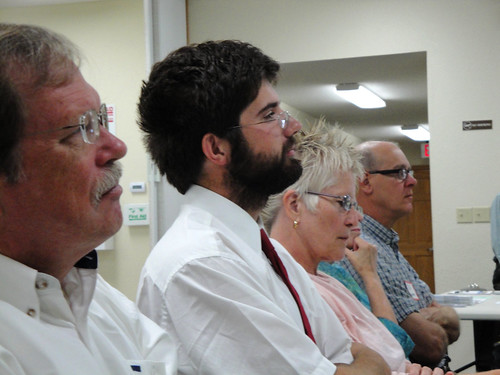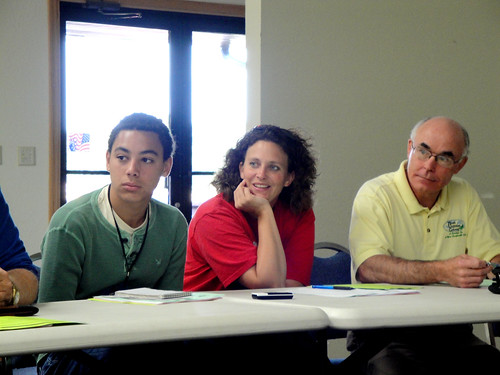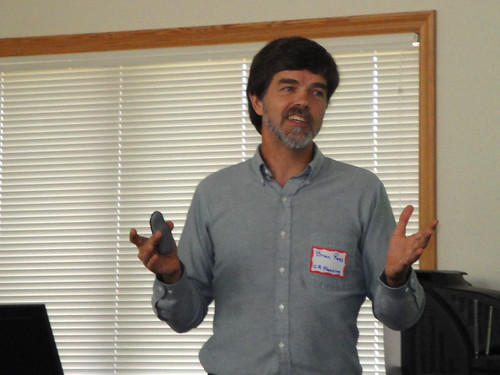Breezy Point, MN: On Tuesday, August 30th, the Central Clean Energy Resource Team paired up with their partners leading the HUD Sustainable Communities Initiative in Central Minnesota to host a session on how to implement the Minnesota GreenStep Cities best practices.
Twenty-five people, including representatives from 17 communities, participated in the session which walked participants through a quick GreenStep Cities overview, stepped through the process of selecting a best practice action from a menu of options, and then shared tips and resources for getting those actions done to achieve a positive community impact.
 Much of what was shared at the meeting can be best learned by reviewing our presenters’ thoughtful presentations:
Much of what was shared at the meeting can be best learned by reviewing our presenters’ thoughtful presentations:
- Angela Headlee, Regional Coordinator, Central CERT/CMAERC, gave an overview of the Minnesota GreenStep Cities Program, its key attributes and features, and about how to get started.
- Brian Ross, Principal/Owner of CR Planning, Inc., walked participants through the “funnel” process of picking a best practice action from within one of the 28 best practices, and then gave examples a city could choose to implement that action in a way that best fit their city’s goals, characteristics and resources.
- Andrea Lauer, Mayor of the City of Royalton, shared the inspiring story of Royalton’s work with GreenStep Cities and on energy efficiency and renewable energy projects more broadly.
- John van der Linden, Minnesota GreenCorps Member with Happy Dancing Turtle and Hunt Utilities Group in Pine River, shared Pine River’s remarkable story of bringing community together to make their own GreenStep actions happen and what they’ve learned along the way.
- Cheryal Lee Hills, Executive Director of the Region Five Development Commission, gave an overview of the HUD Sustainability Communities project and issued an open invitation to anyone in the region to participate in one of their upcoming Resilient Region Workshops.
In addition, the Minnesota GreenStep Cities website is always a good place to go to learn more about each of best practices, how the program works, how to get started, which cities have already signed on, and what those cities have done so far: http://www.mngreenstep.org.
 A few other take home messages from our speakers and meeting participants include:
A few other take home messages from our speakers and meeting participants include:
- GreenStep is a program that you can make work for your community; it’s flexible and allows you to tailor your approach to do what your community wants to do and what it has the resources to pursue.
- There are lots of ways that cities can influence work in their communities. Best Practice Actions are designed to allow a city to take action via one of three mechanisms: actions to affect a city’s own operations, adopting policy to affect change, or providing incentives to encourage others to take action.
- Champions are key! All of our speakers emphasized how important it is to have a local champion – and ideally not just one, but a team of champions. Participation in GreenStep can be a great catalyst for collaboration if that’s how a community approaches it.
- Just get started. It’s easier for people to want to join in if they understand what’s in it for them, and they can see work already taking place. It’s also easier to communicate about specific actions and projects than to talk in broad brush strokes. People want to see how this work is practical and to do that, it must be visible.
 Finally, a few questions that were asked at the meeting that others of you might also be thinking:
Finally, a few questions that were asked at the meeting that others of you might also be thinking:
- Are there calculators that can be used to look at the cost-benefit of certain actions? For some actions there are. The best place to look for these sorts of calculators and examples of estimated rates of return is within each best practice’s benefits section. See an example (in the right hand column). That’s where we include resources about costs and benefits. In the additional resources section you can find more calculators, tools, and resources to make your projects happen. In the future, you’ll also be able to see details about what other cities are implementing, including—we hope—their cost-benefit numbers. See the best practices in a table.
- What about Counties, Townships and Tribal Nations? Right now GreenStep is focused on Cities and the best practices are tailored toward actions cities can take. We hope that in the future there will opportunities to expand the program. In the mean time, there are a variety of ways that any entity and group can be involved… by contributing to a neighboring city’s efforts, by looking how this approach might work for a county, township or tribal nation, or even volunteering your expertise to a group working on a certain best practice category. There are a number of places that are already using these approaches – like Pine River’s approach to move this forward at the community level engaging people from the whole area, not just within the city limits. Similarly, two Tribal Nations have already begun to look at how what they’re doing aligns with the best practices. Several counties have begun to do the same and have even formed best practice task forces to help provide capacity to and spur local action. In the Central region, there’s even consideration of joining efforts along the 371 Corridor. If you have other ideas, let us know!
Bob McLean of Hunt Utilities Group wrapped up our session with a big thank you and send off to John van der Linden who just wrapped up his term as a Minnesota GreenCorps Volunteer. A tremendous thanks to John for all of the work he’s done over the past year! Best of luck in Iowa!
To see more photos from this event, visit CERTs on Flickr or see the slideshow below.
Minnesota GreenStep Cities is a voluntary challenge, assistance and recognition program to help cities achieve their sustainability goals through implementation of 28 best practices. Each best practice can be implemented by completing one or more specific actions from a list of four to eight actions. These actions are tailored to all Minnesota cities, focus on cost savings and energy use reduction, and encourage innovation. For more information about Minnesota GreenStep Cities, visit http://www.mngreenstep.org.

